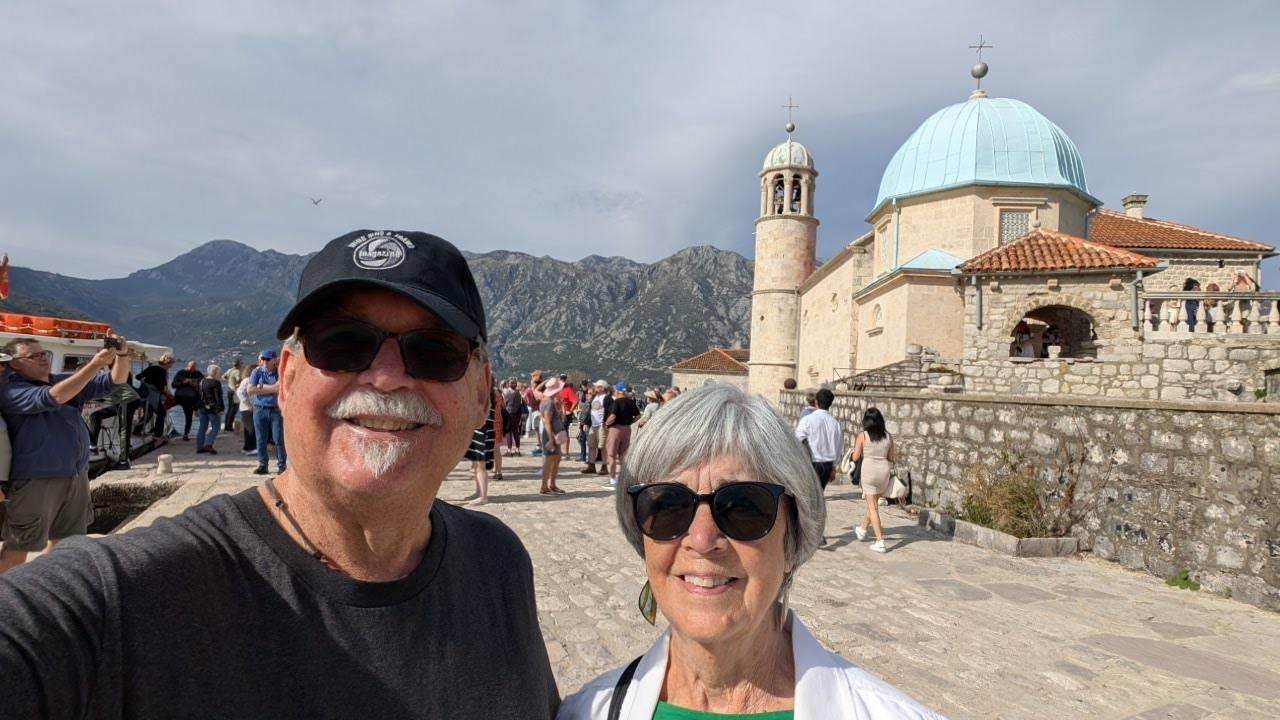Our latest visit to Kotor featured a shore excursion that blended luxury, history, and local charm. We skipped the old town in favor of exploring Porto and Perast, Montenegro, taking in the beauty of Our Lady of the Rocks, and soaking up the stories of the long bay. But before we set foot on land, the journey itself was unforgettable.
As we sailed into Kotor this morning, we were greeted by a spectacular sunrise. The sky lit up in brilliant red-orange hues, casting a warm glow across the rugged mountains and gleaming, mirror-calm waters of Kotor Bay. The ancient storybook villages that dot the shoreline, with their terracotta roofs and white stone buildings, looked untouched by time. It was a perfect introduction to the day ahead, as the scenery seemed to blend seamlessly with the rich history we were about to explore.
Our first stop on our bus and boat tour was Porto, the country’s playground for the rich and famous. Situated along the coast, its marina is known for its mega yachts and ritzy shops—a kind of Rodeo Drive seaside strip mall.
The most luxurious yacht we saw during our stroll was Atilla, an impressive $70 million vessel that dominated the docks with its sleek, modern design. Walking along the boardwalk, we marveled at the sheer opulence of the marina, hotels, and restaurants. All were impressive but seemed out of place in this small country with a tiny GDP.
At the far end of the shopping street, a marine park offered a glimpse into Montenegro’s past under Yugoslavian rule. There, two submarines built locally during that era recalled Yugoslavia’s role as a powerful arms builder. The submarines, now silent and weathered, sit as monuments to a bygone era when the Adriatic was a strategic military stronghold.
We boarded a tour boat to begin our journey across the calm waters of the bay. As we sailed, we passed a notable landmark—The House of the Three Sisters. Its story is as tragic as it is enduring: Three sisters, each in love with a sailor who went off to sea, promised never to marry anyone else and vowed to remain in their house, watching out their bedroom windows for their return. As the years passed, one by one, the sisters died. After the first two passed, the surviving sister bricked up their windows. When the last died, there was no one to shutter her window. It still stares out at sea, a silent testament to the sisters’ undying love. The story added a bittersweet layer to the scenic beauty of the bay.
Soon after, we arrived at Our Lady of the Rocks church, and its story is just as fascinating. According to legend, in 1452, two sailors found an image of the Madonna and Child on a small rock in the sea, and believing it to be a divine sign, they vowed to build a church on that spot. Over the centuries, seamen and villagers living nearby added rocks to the bay after every successful voyage, creating the island where the church now stands.
Inside the church, we were struck by the stunning collection of over 2,500 silver plaques, each left by sailors in gratitude for their safe return. The frescoes, painted by the renowned 17th-century artist Tripo Kokolja, depict religious and maritime scenes, reflecting the close ties between Kotor’s people and the sea. One particularly striking image of the Virgin Mary watches over the altar, decorated with red and rare green marbles.
Our last stop was the picturesque village of Perast, nestled along the shore of the bay. Its charming Baroque architecture, quiet streets, and slower pace of life were a vivid contrast with the bustling marina and its glamorous yachts. At a local café, we indulged in a traditional Napoleon pastry—a delicious treat of layers of puff pastry and creamy filling—along with coffee and tea. Sitting there, overlooking the bay, we savored the peaceful atmosphere that only a small Montenegrin village can provide.
As we made our way back toward our tour boat, we didn’t see any of the town’s cats. Perast, like Kotor, has a deep love for its feline residents. In the past, these cats kept the rat population in check, but these days, the cats are far too pampered and well-fed to bother hunting. Instead, they bask in the affection of locals and tourists alike.
For us, tiny Montenegro was well worth a second—and perhaps a future—visit. There are more fascinating stories to glean from this unique place on the Adriatic.





